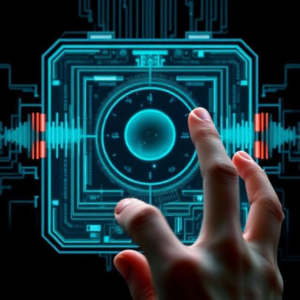Haptics Technology:
Haptics is a technology that uses touch to provide feedback or create sensations for users. It’s all about simulating the sense of touch through devices, allowing you to feel things in a virtual or digital world. When you interact with something on a screen or in a virtual environment, haptic technology gives you feedback, like vibrations or motions, that mimics how you would feel if you were actually touching or interacting with a physical object.
Think about the way you feel when you touch something:
- When you touch your phone screen, you feel the pressure and maybe a little vibration.
- When you play video games, you might feel a rumble or vibration when your character jumps or when there’s an explosion.

How Does Haptic Technology Work?
Haptic technology works by creating sensations that mimic touch or force using vibrations, motions, or forces. The most common ways it works are:
- Vibrations: This is the most common form of haptic feedback. For example, your phone vibrates when you get a notification.
- Force Feedback: Some devices can push back or apply force when you interact with them. For instance, in a racing game, your steering wheel might shake to simulate a car’s movement or to simulate hitting something.
- Motion: Some devices can simulate a physical sensation of motion. For example, in virtual reality (VR) games, a glove or suit might move with you, creating the illusion of touching or moving through a digital world.
Everyday Examples of Haptic Technology:
- Smartphones: When you type on your phone’s touchscreen, you feel a little vibration or “click” sensation. This is haptic feedback, giving you the sensation that you’re actually pressing a button.
- Game Controllers: In video games, especially on consoles like PlayStation or Xbox, the controller vibrates when something happens in the game, like when you crash into something or when there’s an explosion. This helps make the game feel more real by adding a physical feeling to what you’re experiencing visually.
- Virtual Reality (VR) and Augmented Reality (AR): In VR games, you wear special gloves or suits that have haptic sensors. These allow you to “feel” virtual objects, like the texture of a ball or the impact of an object in the game. It makes the experience more immersive and real, even though you’re in a completely digital world.
- Wearable Devices: Some fitness trackers and smartwatches use haptic feedback to alert you, like vibrating when you get a message, a reminder, or when you achieve a fitness goal. It’s like receiving a gentle tap on your wrist.
- Medical and Rehabilitation Devices: Haptic technology is used in devices that help people with physical therapy. For example, a device might provide vibrations or resistance to guide a patient’s hand to move in a specific direction, helping them regain mobility.
Why Is Haptics Important?
Haptics is important because it adds a sense of touch to technology, making digital experiences feel more realistic and interactive. By using haptic feedback, devices can communicate more than just sight and sound. It helps users better interact with virtual worlds, receive alerts, and even understand the environment around them, which is especially useful in gaming, medicine, and accessibility.
Conclusion
Haptic technology is all about bringing the sense of touch into the digital world. It lets you “feel” things through vibrations, forces, and motions. Whether it’s vibrating your phone when you get a notification, making video games feel more real, or helping people with rehabilitation, haptics makes technology more immersive and interactive by simulating the feeling of touch.
Tags: accessibility, AR, augmented reality, digital interaction, digital world, feedback, fitness trackers, force, force feedback, game controllers, Gaming, gloves, haptic feedback, haptic technology, Haptics, Haptics technology, immersive experience, interaction, interactivity, medical devices, motion, notifications, physical sensation, pressure, realism, rehabilitation, resistance, sensations, simulation, smartphones, smartwatches, suits, tactile response, texture, touch, user experience, vibration, virtual environment, virtual reality, VR, wearable devices


